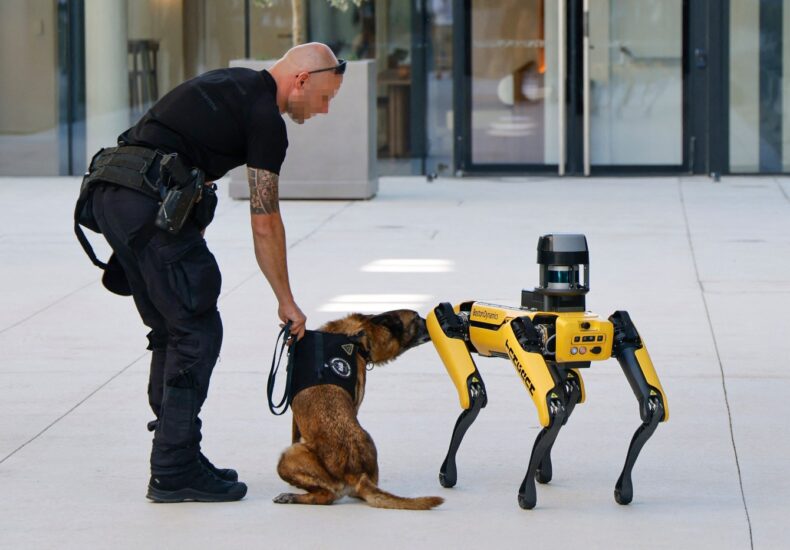
These robot dogs are becoming standard on police forces — leading to concerns
Spot, the four-legged robot from Boston Dynamics Inc., is perhaps best known for its viral dance routines to songs like “Uptown Funk.” But beyond its playful antics, Spot’s ability to climb stairs and open doors signals a potentially controversial role as a policing tool. Five years after its commercial debut, the 75-pound, German Shepherd-sized robot is increasingly being deployed by local law enforcement to handle armed standoffs, hostage rescues and hazardous materials incidents situations where sending in a human or a real dog could be life-threatening. More than 60 bomb squads and SWAT teams in the US and Canada are now using Spot, according to previously unreported data shared by Bost The use of such technology raises questions about ethics, oversight and the risks of military-grade tools being deployed in civilian settings. Defense and public safety agencies are increasingly adopting cutting-edge technologies to enhance their operations. Defense tech funding has soared past $28 billion in 2025 up 200% year over year, even as broader venture markets cooled, according to PitchBook data. Robots in particular have been finding a home among law enforcement agencies. ICE, or US Immigration and Customs Enforcement, recently spent around $78,000 on a robot from Canadian tech manufacturer Icor Technology Inc. that can perform similar tasks as Spot and also deploys smoke bombs, according to contract records. Spot’s role on law enforcement teams varies. In 2022, it approached a man who had crashed a car trying to kidnap his son in St. Petersburg, Florida, to keep an eye on the situation and see if he was armed. In Massachusetts last year, in two different incidents, it helped assess a chemical waste accident at a middle school in North Andover, and it intervened when a suspect in Hyannis took his mother hostage at knifepoint and fired at officers. Spot was deployed to corner him and police eventually followed with tear gas to apprehend him. “It did its job,” said trooper John Ragosa, a Massachusetts State Police bomb squad member and the Spot operator assigned to the hostage-rescue mission. “The suspect was stunned, thinking ‘What is this dog?’” The robot, which starts at around $100,000, can operate autonomously in many cases performing maintenance checks, detecting gas leaks and inspecting faulty equipment but still relies on human operators like Ragosa for decision making. Using a tablet that resembles a video game controller, an operator guides the machine while monitoring a live video feed from its onboard camera system. Additional built-in sensors handle navigation and mapping. During high-stakes situations, officers can also view the live feed on larger nearby screens. Spot’s technology continues to evolve. The company recently added a mode to help Spot navigate slippery spots. And it’s working to help Spot better manipulate objects in the real world. The use of robots in emergency situations is hardly new. Police bomb squads have relied on ground robots since the 1980s, but their deployment became more widespread in the early 2000s, according to Robin Murphy, a professor emeritus of computer science and engineering at Texas A&M University. What makes Spot stand out, she said, is its four-legged design giving it far greater agility and dexterity than traditional robots that move on tracks or wheels. Roughly 2, 000 Spot units are now in operation globally, Boston Dynamics said. The deployments include organizations such as the Dutch Ministry of Defense and Italy’s national police. While most of the company’s customers are still industrial clients, including manufacturers and utility providers, interest from law enforcement has surged over the past two years, said Brendan Schulman, Boston Dynamics’ vice president of policy and government relations. The Massachusetts State Police currently owns two Spot robots one purchased in 2020 and another in 2022 each costing about $250,000, including add-ons, and funded primarily through state grants, Ragosa said. He said he hopes the agency will add a third unit soon. Some other major cities also have fleets: Houston operates three Spots, while Las Vegas has one, Boston Dynamics said. Not all departments are equipped to own advanced robots, Murphy said, adding that the question is whether the high cost and complexity of legged robots are worth the extra mobility they provide. Costs aren’t the only concern. Some civil liberties groups and technologists warn that using semi-autonomous robots in law enforcement could normalize a more militarized approach to policing. In 2021, the New York Police Department suspended for a time its limited use of Spot following public backlash, with critics questioning both the expense amid city budget constraints and the robot’s broader role in surveillance. The NYPD later reinstated the program and went on to purchase two of the robots, according to Boston Dynamics. Some larger police forces also deploy military-grade robots such as PackBots, originally developed by iRobot Corp. They have long been used in disaster response, including at the World Trade Center site in the aftermath of the September 11 attacks, where they helped search through debris. Boston Dynamics also says it requires its public safety customers to outline how exactly Spot will be used before they ship a unit. Beryl Lipton, senior investigative researcher at the Electronic Frontier Foundation, or EFF, said companies can only do so much to limit how their tools are used when they are in the hands of law enforcement. “You can’t really rely on the goodwill of a particular company when it comes to almost any of these technologies,” she said. “It doesn’t matter who makes the gun in general, there are rules about how guns get to be used.” From a surveillance standpoint, Lipton said the EFF believes there should be state and ideally federal laws providing basic guidance on what is appropriate. While she acknowledged they aren’t going to “hold our breath” waiting for a specific application to be regulated, she emphasized the need for public disclosure and involvement from local city councils and elected oversight bodies. She also expressed concern that the use of robot dogs helps law enforcement agencies put a friendly spin on the accumulation of technology that can be used for policing. “One of the things about the so-called robot dogs that we are a little wary of is this normalization and this sort of affectionate framing of calling it a dog,” she said. “It’s normalizing that for the public when it’s not actually a dog. It’s another piece of police technology.” Ryan Calo, a professor at the University of Washington School of Law focusing on robotics law, said that the technology could deepen public skepticism toward law enforcement, and said clear guidelines are critical for safe deployment. “The unease people feel around robotics is not just a psychological quirk,” he said. “They are disconcerting for a reason. The overuse of robotics in policing will further dehumanize police to the public and break down those community ties that have been so important to policing over so many years.” Ragosa from the Massachusetts State Police said his force also uses drones and other robotics on certain missions. But the advantages of using Spot, in his view, is that it can often go where many other drones can’t, and it can work more efficiently than other robots. The battery life is also longer, he added: about an hour and a half for Spot, in his experience, compared with 20 to 30 minutes for drones. It can also typically perform better indoors and be taught to run autonomous missions without a teleoperator, Calo said. “Few drones can do this reliably,” he said. Still, Calo believes robotics can play a valuable role when used transparently and within clear boundaries. “I don’t think every police officer needs a robot partner,” he said. “But the use of robots in certain situations that have been specified in writing in advance is good. No one wants police to risk their lives or fail to gain situational awareness during an emergency nor do we want to live in a robotic police state.”.
https://www.pilotonline.com/2025/11/22/robot-dogs-police/
You may also like

Netflix’s Top 6 Movies Today (Saturday, Nov. 22, 2025)
The Pixel Watch 4’s quiet upgrade that actually matters

10 Best Crime Shows With Less Than 5 Seasons, Ranked
You may be interested
Globe bets on prepaid fiber, sets expansion
No content was provided to convert. Please provide the text...
Bragging rights up as Samal makes 5150 debut
A stellar Open division field will be shooting for the...
DigiPlus launches P1-M surety bond program
MANILA, Philippines — DigiPlus Interactive Corp. has partnered with Philippine...
 The New York Times
The New York Times
- G20 Leaders Push Back on Trump’s Ukraine Peace Plan 2025 年 11 月 22 日 John Eligon and Michael Schwirtz
- COP30 Climate Summit Ends With Dire Warnings and Scant Plans for Action 2025 年 11 月 22 日 Max Bearak and Lisa Friedman
- Pushing Off 2025 年 11 月 22 日 Melissa Kirsch
- This Washington Museum Sold Some of Its Art. But at What Cost? 2025 年 11 月 22 日 Robin Pogrebin
- The Surprise Ending to the Trump-Mamdani Buddy Movie Has Heads Spinning 2025 年 11 月 22 日 Dana Rubinstein and Benjamin Oreskes
- U.S. and Ukrainian Officials to Meet Again on U.S. Peace Plan 2025 年 11 月 22 日 Helene Cooper
- ‘Fascist’? ‘Communist’? For an Afternoon, Trump and Mamdani Were Just 2 Guys From Queens. 2025 年 11 月 22 日 Shawn McCreesh
- Jair Bolsonaro Arrested in Brazil Amid Fears He Might Flee to Avoid Prison 2025 年 11 月 22 日 Ana Ionova
- Ukrainians Wait in Pain as Hope to Find Strike Survivors Fades 2025 年 11 月 22 日 Kim Barker, Oleksandra Mykolyshyn and Mauricio Lima
- Marjorie Taylor Greene Says She Will Resign in January, After Break From Trum 2025 年 11 月 22 日 Annie Karni
Leave a Reply